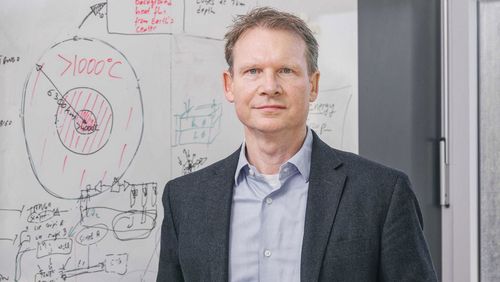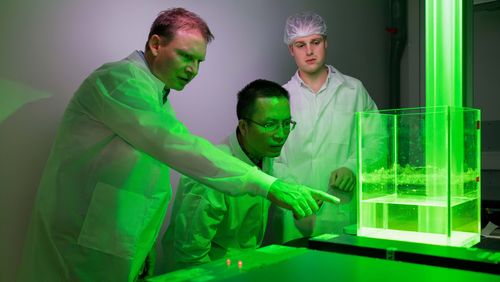
Underground lightning bolts
The earth’s crust is a gigantic heat reservoir. But accessing this infinite source of energy has proven elusive thus far. Now, however, an electropulse drill developed by geophysicist Martin O. Saar could provide the solution for harnessing the earth’s heat—and using it for cost-effective power generation.
The heat pumps and downhole heat exchangers used for heating residential buildings exploit relatively small temperature differences: the underlying principle functions when the fluid in a heat exchanger records just ten degrees—temperatures found already at depths of less than one hundred metres beneath the earth’s surface. For large-scale power generation, however, higher tempera-tures are needed, and this kind of heat is generally found only many kilometres deep in the earth’s crust, with the exception of volcanic regions like Iceland.
Researchers have spent decades seeking ways to access the heat in the earth’s crust, as there are few areas in the world where underground rock layers are naturally so porous as to enable hot water to be simply pumped up to the surface from a reservoir and subsequently used to generate power. Where the subsurface is impermeable, the rock layers must first be blasted open; as such, harnessing this kind of petrothermal geothermal energy at a depth of five to eight kilometres often relies on triggering artificial, unpredictable earthquakes. A further problem is that underground water is often saturated with salt, which can precipitate (cause deposits) when the water cools, clogging pumps and rock pores. Last but not least, drilling at these depths is hard on the drill bits, which must be replaced on a daily basis.
Electroshock therapy for rock layers
All this has motivated Professor Martin O. Saar to work with his research group at the Swiss Federal Institute of Technology Zurich (ETH Zurich) and their academic and industry partners on the development of new drilling methods. One highly promising technology already undergoing testing is an electropulse or plasma drill, which the team have named Plasma Pulse Geo Drilling (PPGD). With PPGD, brief electric impulses lasting less than 500 nano-seconds are generated by massive jolts of up to 600 000 volts. Two electrodes affixed to the rock surface then act like a massive lightning bolt, engendering a so-called plasma state (the fourth state of matter) in the rock layer. The instantaneous thermal expansion and pressure plasma that result are enough to mechanically break up the rock. This method inverts conventional drilling principles, which apply pressure from above: with PPGD, tensile force is exerted on the rock from below. The major advantage of this approach is that only a quarter of the energy of conventional methods is needed to act on the rock and fracture it.
Downsizing the generator
One current challenge is the size of the pulse generator used to produce the 600 000 volts. At present, it is so large that it needs a shipping container to function as a Faraday cage. Saar aims to reduce the generator’s size to a diameter of a mere fifty centimetres, allowing it to be sunk several kilometres into the earth through a narrow borehole. That the pulse generator fit into the borehole is critical, as the electric pulses must be generated directly where the drill bit is located. Were an electric cable to deliver power, the high-voltage pulses would increase too slowly, resulting in a short circuit between the electrodes located in the drilling fluid. Only “high-speed lightning bolts” have the capacity to traverse the rock in the intended arc and to break up the rock from below.
Drilling sideways
Martin O. Saar is already testing the Plasma Pulse Geo Drilling technology in collaboration with SwissGeoPower, a geothermal power plant builder, an undertaking financed by an Innosuisse Grant of the Swiss Innovation Agency. In recent years, SwissGeoPower has made a significant contribution to further developing PPGD; the German Fraunhofer Research Institution for Energy Infrastructures and Geothermal Systems is also participating in the tests. “This method would be a real breakthrough. Drilling would become much less expensive, and geothermal energy generated from particularly deep depths of over four kilometres would finally be competitive,” says Martin O. Saar.
Moreover, the system could do what traditional rotary drills are incapable of: creating cavities in the subsurface that are larger than the borehole leading to it. This is because the electropulse drill can bore sideways, implementing even complex geometric specifications with utmost precision at depths of up to ten kilometres. The technology would also make it possible to improve the connection between borehole and heat reservoir. With this method—which is economically interesting and does entirely without fracking—fluids and energy could be extracted from, or stored, deep in the earth. As such, it harbours great potential for applications beyond geothermal energy production, including energy and carbon dioxide storage, groundwater use, oil and gas extraction and nuclear repositories.
Strong support
The signs are promising. As principle researcher in an association of research groups from ETH Zurich, the Paul Scherrer Institute, the Eastern Switzerland University of Applied Sciences as well as private companies, Martin O. Saar received additional project funding in October of 2021: an Innosuisse Flagship Grant worth nearly twelve million Swiss francs. Now, work on reducing the size of the high-voltage pulse generator can proceed with united forces.
Text: Sabine Witt
Illustration: bigfish AG








